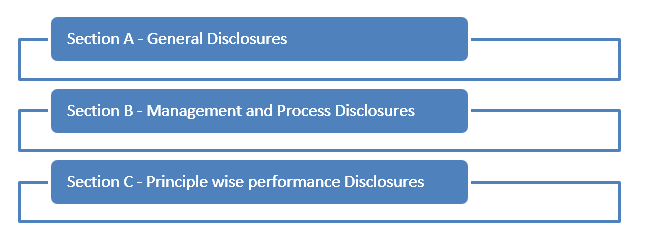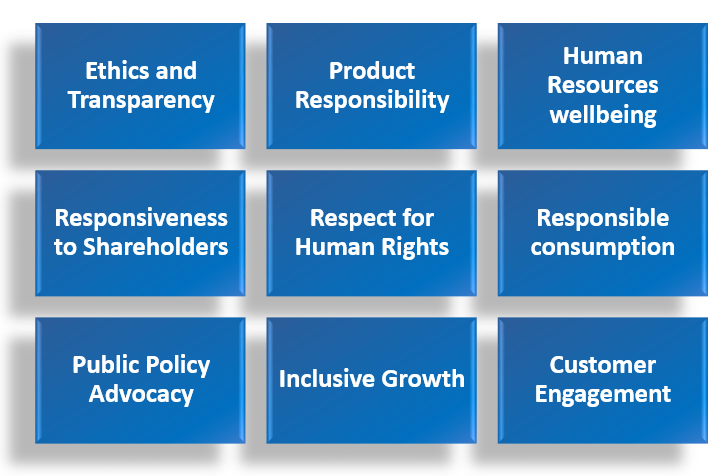Introduction
In our earlier article on Why Environment, Social and Corporate Governance is crucial to business we laid out the foundation on ESG`s applicability, considerations and benefits. Moving ahead, we direct our efforts to the Reporting aspects of Business Responsibility and Sustainability Report (BRSR)
What purpose does BRSR serve?
It helps the stakeholders to analyse companies on non-financial aspects, to keep a check on the responsibility and sustainability towards environmental and societal forefront. Companies will be able to demonstrate performance, objectives and position into long term value creation, to discharge responsibility with utmost commitment hence stakeholders will be in a better position to take decisions about the company
Decoding
Let us decode the BRSR in detail
The report consists of 3 Sections

Section A – General Disclosures
It requires basic details such as name of company, CIN, registered office address, contact details, paid up capital, name and contact details of the person responsible for BRSR, details about the operations, products and turnover. Further details about the gender ratio of employees and workers, representation of women at the top management and turnover ratio of the employees, group companies structure reporting, CSR Details have to be disclosed. Such details form’s a part of different compliance reports that needs to be reported.
Important aspects to be taken care of here is of Transparency and Disclosure Compliances
- Reporting of compliant / grievances: compliant / grievances raised by different stakeholders on principles mentioned in Principle wise performance disclosure (Section C) is required to be disclosed. Here stakeholder wise disclosure is required, of complaints filed during the year, it`s status as on year end, remarks if any, whether a grievance redressal mechanism is in force. This enables all the stakeholders to have a broad view of compliance of the principles and on part of company to address the complaints on priority and diligent manner.
- Reporting of business conduct and sustainability issues pertaining to environment and social matters. Each material item of risk / opportunity along with the reasons for identifying them as one, approach to adapt the opportunity or mitigating strategy for the risk should be disclosed. It also requires disclosure of risk / opportunity impact on the financial statements.
For example – An IT Company can have Data Security as its risk where cyber-attacks or data leaks can be the identifying factor for consideration, disclosure of the controls / policies put in place by the company to mitigate them, effect of such risk on financial statement such as risk of losing the customers has to be disclosed.
Section B – Management and Process Disclosures
This Section requires a questionnaire to be answered by the company on various aspects of principles mentioned in Principle wise performance disclosure (Section C) namely on Policy management process, Governance leadership and oversight.
The Policy management process requires the company to disclose the existence of policies on the principles, related goals target set by the company for eg. To achieve carbon neutrality after certain years etc., performance achieved by the company till now against those goals have to be stated…etc
The Governance leadership and oversight requires information about the leadership team responsible for the oversight, their comments on the ESG issues, challenges and their targets, details of review undertaken by board /committee with it`s frequency and external agency details if it is reviewed by them, this will help the investors to understand the leaders and their leaderships process in a better manner.
Compliance of the processes cannot be achieved overnight but by setting up a vision, a purpose and an aspiration to do more, to navigate the path forward to create the future that is sustainable and responsible in all aspects. To create value for the nation, enhance quality of life across the entire socio-economic spectrum and help our society as a global leader in the domains where we operate.
Section C – Principle wise performance disclosure
This section is aimed at helping entities demonstrate their performance in integrating the Principles and Core Elements with key processes and decisions. The information sought is categorized as “Essential” and “Leadership”. While the essential indicators are expected to be disclosed by every entity that is mandated to file this report, the leadership indicators may be voluntarily disclosed by entities which aspire to progress to a higher level in their quest to be socially, environmentally and ethically responsible
There are nine principles in this section, principle wise disclosure is required. It requires the company to follow the ethics in letter and spirit, to achieve growth but also take care of the interest of all stakeholders of the company. A detail disclosure about existence, effectiveness of policies, committees, breakup of various stakeholders covered in the principles, status of grievances have to reported in a questionnaire report.
Nine Principles –

Conclusion
BRSR reporting requirement is a colossal activity for the company but it will pave the path for different forms of KPIs to be referred by the different stakeholders.
It will set the mandate of Growth but with responsibility and sustainability.
Full format for BRSR by SEBI can be found in the given link – BRSR Report
Authors:
Umesh Vishwakarma
Manager | Email: umesh.vishwakarma@masd.co.in | LinkedIn
Manav Bokadia
Associate Consultant | Email: manav.bokadia@masd.co.in | Linkedin

